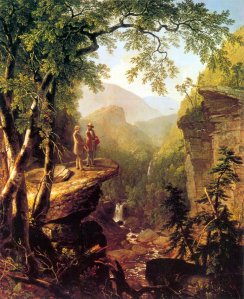Asher Durand’s Kindred Spirits (1849) at first appears to be a picturesque landscape, but upon closer inspection it has undertones of man’s dominance of nature. The painting features two men- painter Thomas Cole and his friend, writer William Cullen Bryant- standing on a rocky outcropping overlooking a river valley. The landscape is very typical for the time. The scene is framed by a cliff on the right side and a group of trees on the other. It even has the stereotypical storm-blasted tree in the lower left corner.
While the painting consists of mostly nature, it is clearly not the focus of the artwork. The two figures are near the center of the painting and there is nothing obstructing our view of them. They are looking out at the landscape, surveying it. It shows their mastery over nature. The landscape is there for their viewing alone. Even the title of the painting shows that the point of the painting is not the natural environment, but the men in it and their reactions and interactions to it. Either way, nature is just a backdrop for the conquests of men.


Hannah,
You’ve provide just a snippet of information about painting and it really is too short — there are so many things that you could talk about, including why you even want to talk about it in the first place! What is intriguing you?
Its a really good idea to do a little research on works of art that you want to write about. I would suggest that you do an internet search and look for links to musuems. For example, if you Google the artist’s name and the title of the painting, you’ll find a like to the National Gallery of Art which has lots of information and links to even more information. Here’s the link: http://www.nga.gov/exhibitions/durandinfo.shtm
Use information from sites like this to inform your thoughts and writing.
Thomas Cole would have resented the idea that he wanted to “dominate” nature. He was flagrantly opposed to anyone who thoughtlessly exploited his beloved wilderness, and humble in his own approach to the natural world, viewing it as his teacher–something beyond himself that he was very small in the face of, worthy of his respect, and uniquely able to communicate the beauty, grandeur, and intricacy of its creator. His paintings were not a quest to reduce the natural world to something beneath him, but to carefully reveal all the beauty he saw in it; he was “getting out of its way” insofar as he could, and seeking to let it shine through on its own merit, the same way you respect a friend not by describing him only in terms of what you approve about him, but by describing what he is like as honestly and lovingly as possible. Durand knew Cole, and would have understood this about him–this painting, made in honor of Cole after his death, reflects such an attitude, presenting two friends unobtrusively enjoying a landscape they both love, and enjoying the bond that comes from that love.
The Romanticist/Transcendentalist mindset held by Durand, Cole, and contemporary writers is foreign to many of us today, but in the spirit of tolerance and respect, we would do well to seek to understand them instead of slandering them and letting prejudice shape our attitudes toward them.